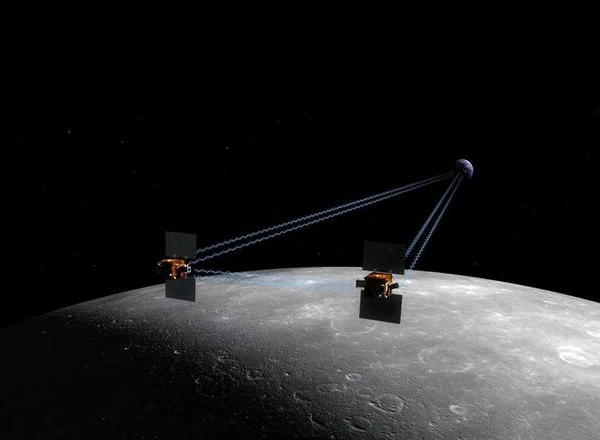
The GRAIL mission, launched in 2011 by the NASA, aimed to measure variations in the Moon's gravitational field with unprecedented precision. The identical probes, Ebb and Flow, were placed in near-circular polar orbits to detect even the smallest density anomalies inside the Moon. Their operation relied on ultra-precise measurement of the distance between them via a microwave link sensitive to micron-scale variations.
When one probe passes over a denser lunar region, it experiences slightly stronger gravitational attraction and accelerates. This relative variation changes the distance between the two satellites, continuously measured by microwave interferometry. By correlating these distance changes with orbital position, scientists reconstructed a global gravitational map of the Moon, revealing its internal structure with unprecedented resolution. The principle is based on the relation \(\Delta g = \frac{GM}{r^2}\), where \(\Delta g\) represents the local variation of the gravitational field.
The obtained maps allowed estimation of the lunar crust thickness between 34 and 43 km, thinner than expected. They also revealed a complex network of fractures beneath large impact basins, indicating a rigid and fractured crust. These data provided essential insights into mantle differentiation and the crystallization of the initial lunar magma, as well as the satellite's thermal evolution since formation.
| Parameter | Value | Unit | Comment |
|---|---|---|---|
| Average altitude | 55 | km | Near-circular orbits for optimal gravimetric resolution |
| Average distance between probes | 200 | km | Continuously measured via microwaves, sensitive to <1 µm |
| Orbital period | 113 | minutes | Fine synchronization to detect local gravitational gradients |
| Gravitational resolution | ≈30 | km | Spatial limit of the final map produced by GRAIL |
| Scientific mission duration | 9 | months | March to December 2012, before controlled lunar impact |
Source: NASA - GRAIL Mission Overview.
The principle of differential gravimetric measurement directly derives from the GRACE project, developed in the early 2000s by Byron Tapley (1936-) and collaborators. Both missions demonstrated that gravity could become a planetary internal probing tool as powerful as seismology.